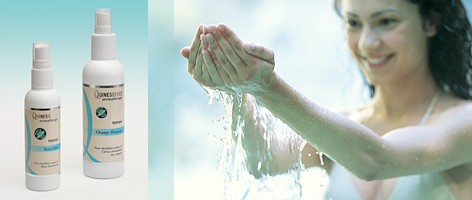
What are Hydrosols?
A hydrosol is the condensate water that is left over after the process of extracting an essential oil by water or steam distillation. This aromatic water contains the very essence of everything that was contained within the plant when it was still alive and growing.
When essential oils are extracted by steam distillation, some of the aromatic and healing principles held within the plant are not captured during the process. These important components do not escape into another dimension or disappear into a black hole, fortunately they are absorbed by the steam or water that is used to extract the oil.
This steam eventually condenses back into water, and now contains small quantities of essential oil plus many of the water-soluble (hydrophilic) parts of the plant. Now supercharged with more active principles than the essential oil from the plant, this ready to use product offers a safe and convenient way to deliver a wide range of therapeutic and cosmetic benefits.
See the full range of pure and natural Hydrosols from Quinessence.
What's in a name?
Technically described as a distillate water, this type of fragrant co-product has been more recently referred to in aromatherapy as a hydrosol, hydrolate or hydrolat. Prior to this in the United Kingdom, all distillate waters were collectively known as 'flower waters' or 'floral waters', and the availability was usually restricted to just a popular few such as lavender, rose and orange flower.
The historic term of floral water is now seriously outdated since every essential oil extracted by a process of water or steam distillation produces a distillate water as a co-product. There are now a much larger selection of distillate waters produced from herbs, needles, leaves, woods, roots, barks and seeds widely available. So the term floral water is not consistent with these products and the name of hydrosol is being used somewhat inconsistently as we will see later.
Aromatic pendulum
Until the Middle Ages the art of water distillation was employed specifically for the purpose of producing these precious aromatic waters, and amazingly, very little attention was paid to the precious essential oil that was produced.
Essential oils were utilised of course, but they were extracted by infusing the plant material in a vegetable oil until it had absorbed all of the healing properties of the volatile oils. The Egyptians, Greeks and Romans are all known to have made great use of hydrosols for healing and aesthetic properties along with their infusions and unguents.
The precise time in history when distilled essential oils became popular in Europe is not known, but a renowned publication called 'Liber De Arte Distillandi' written by Hieronymus Brunschwig in Strassburg 1507 AD makes reference to only 4 essential oils.
Suffice to say that as essential oils became increasingly more popular, the use of hydrosols began to slowly decline. By the early 20th Century the healing benefits of these miracle waters were generally being ignored, with the precious hydrosols actually being thrown away after distilling the essential oil. The aromatic pendulum had now swung the other way, - but why is this, you may wonder?
Heavy water
It was the logistics of transportation that had caused this decline in interest, because the high shipping costs from the country of manufacture far outweighed any realistic commercial value for this relatively low value co-product.
The only exceptions were perhaps rose and orange 'floral waters' which were still quite popular up until the 1950's, when they began to be replaced with cheaper synthetics in the U.K. Pharmacies had begun to sell a synthetic concentrate of rose or orange flower which was diluted at home and used in cake icing, cooking or salads.
It is only quite recently that there has been an increase in interest for these ready to use products, and this is of course great news. Unfortunately, newcomers to aromatherapy are often confused by the different terms used, leaving them unsure as to exactly what is, and what is not, a true hydrosol. And who can blame them, given the dubious practices of some less knowledgeable suppliers?
Is it the real thing...
Like essential oils, the aroma of a hydrosol may vary from season to season even when it comes from the same geographical location. This is because the weather can have a dramatic effect on the plant whilst growing, and during seasons of extreme heat, rain or drought, the plants delicate chemistry is changed which in turn affects the fragrance of its essential oil.
In addition, the chemistry of a plant is affected by the soil that it is grown in, therefore the aroma of a particular essential oil or hydrosol will be different according to its country of origin. These slight variations can often be an indication that a hydrosol is natural, and not man-made.
You may be surprised to learn that many of the 'floral waters' available today have been made with synthetic compounds which have no therapeutic or beautifying qualities. Others are produced by adding essential oils or absolutes to water by using alcohol or some other type of dispersant or solvent. This may appear to be perfectly acceptable, since the finished product contains essential oil and has a pleasant fragrance similar to a natural hydrosol.
However, this type of reconstituted product lacks the wealth of vital healing properties present in a true hydrosol, - remember, many of the plant constituents were dissolved into the water whilst extracting the oil, so they were never present in the essential oil in the first place! Therefore adding an essential oil to water will never create a product with the same range of healing benefits as a true hydrosol. There is simply no substitute for a true hydrosol, so don't let anybody try and fool you.
Buyer beware!
Of late it has become quite common for these man-made products to be misleadingly referred to as hydrosols or hydrolats by some manufacturers and suppliers, thus making the situation extremely confusing. Be sure to seek reassurances that you are buying a natural, co-product and not a re-constituted counterfeit.
Take care when buying hydrolates produced from sources such as citrus fruits or flowers that are usually extracted by solvents. Since citrus essential oils are cold pressed and not steam distilled, these hydrosols must be specially made and are not at all common. Jasmine 'hydrosol' is another example that should be purchased with caution since the oil is almost exclusively extracted by the use of solvents and can not be steam distilled. Always make enquiries before buying hydrosols such as these.
Aroma-therapeutic uses
Hydrosols are highly versatile and can be used for personal care and around the house. In skincare, Rose, Orange Blossom (Neroli) and Lavender hydrosols are great for hydrating dry skin and cooling hot and sensitised skin. If you have been out in the sun too long and got burned, Lavender hydrosol is soothing and comforting as well as healing. Used in the final rinse after shampooing hydrosols help to condition hair and add a shine.
We know of no better remedy for puffy, dark circles under the eyes than Chamomile hydrosol. Just soak two cotton wool pads with the hydrosol and cover each eye for around 10 minutes for an immediate and dramatic reduction in puffiness. Regular use can help diminish those dreaded dark circles too.
Perfect for summer
During the summer hydrosols are perfect to use as a cooling body mist, and the most cooling of all is Peppermint. Make sure you take some with you to use on holidays, on the beach and even to cool those aching tootsies when you are out shopping! Hydrosols help to revitalise you when your energies are beginning to flag, and a few sprays onto a tissue makes a handy wet-wipe for all sorts of applications including babies and grubby children.
To calm a restless baby try adding a few tablespoons of Lavender or Chamomile hydrosol into their bathwater. This can be especially beneficial if your baby is suffering from nappy rash or eczema, because the soothing properties of these hydrosols help calm the irritation and speed up the healing process.
Hydrosols are quite safe to use on young children, and since they only contain a small amount of essential oil they do not need diluting much further except as above when using with very young babies.
Hydrosols such as Rose or Neroli can be added to the final rinse water in your washing cycle as well as used as a fragrant linen spray whilst ironing since they smell much nicer than their synthetic counterparts. Around the house, hydrosols are great to freshen the air instead of using aerosols which of course are harmful to the environment.
Copyright © Quinessence Aromatherapy Ltd 2004. Written by Geoff Lyth
If you enjoyed this article, please click the 'Like' button and help spread the word:
Next Glossary of Terms
See also Quinessence Hydrosol Range


